Complete guide of Different Types of Sushi!
When you think of Japanese food, the first dish that comes up to your mind would be sushi. Yes, sushi is one of the typical Japanese dishes, and Japanese people enjoy eating sushi with friends or family.
But did you know that there are many types of sushi?
Other than nigiri and rolled sushi which may be familiar to you, but many different types of sushi that you have probably not heard of are found in Japan.
Today Japadventure introduces 8 different types of sushi.
What is sushi?
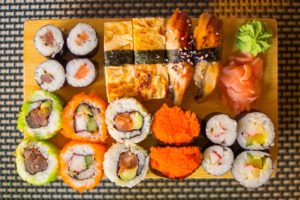
First of all, what is sushi?
Sushi is a Japanese dish using vinegared rice and raw/cooked fish. Fish is mainly topped with rice, but sometimes eggs and vegetables are also topped.
So sashimi, often confused with sushi, is not sushi. Sashimi is sashimi.
For the differences between sushi and sashimi, please read this:Nigiri vs. Sashimi; What is the Difference?
1.Nigiri
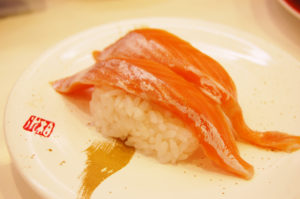
Nigiri, or nigiri zushi is a dish with small vinegary rice topped with an ingredient such as raw/cooked fish, an egg omelet, or vegetables. Most nigiri contains wasabi between the rice and the ingredient, and is eaten dipped in a little bit of soy sauce. But some nigiri does not have wasabi, and some nigiri is eaten with a special sauce instead of soy sauce. You can order nigiri by one piece at sushi restaurants, but at kaitenzushi (go-round sushi) restaurants, nigiri often comes in two pieces.
Sushi chefs should be skillful enough to treat fish properly, find out fresh ingredients, and make delicious sushi, so it is said that it takes ten years to become a professional sushi chef.
Here are common nigiri
-sake(salmon)
-maguro(tuna)
-tamago(egg omelet)
-ika(squid)
-ebi(cooked shrimp)
-amaebi(sweet shrimp)
-tako(octopus)
-buri(adult yellowtail)
-hamachi(young yellowtail)
-anago(conger eel)
-hotate(scallop)
-aji(Japanese jack mackerel)
-toro(fatty bluefin tuna belly)
2.Makizushi
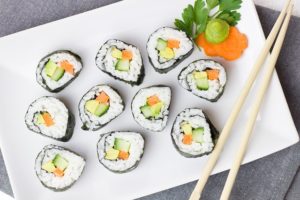
Makizushi is rolled sushi. It is made with a thinly cut ingredient at the center with vinegared rice around and rolled with seaweed paper(nori). Makisu (a bamboo mat) is used when making makizushi. Ingredients can be either fish or vegetables. Makizushi had already existed as early as the 1700s, soon after nori was invented with a similar process to make paper.
Unlike rolled sushi found in foreign countries, Japanese makizushi does not have the rice on the outside and nori on the inside. Inside-out sushi such as California roll is called “western-style sushi.” Also, Makizushi is not a major type of sushi served at sushi or Japanese restaurants but can be found more often at convenience stores or supermarkets.
Makizushi has four kinds according to its size and appearance.
-Hoso maki
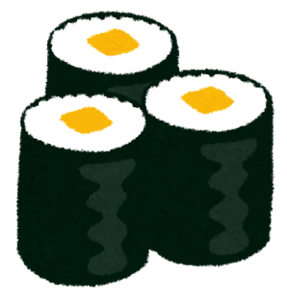
Hoso maki, or thin roll is basic makizushi. It contains one ingredient at the center and is cut into one-bite sizes when served. Familiar ingredients are Kamoyo (boiled seasoned gourd strips), cucumber, pickled daikon radish, natto (fermented soybeans), and tuna.
-Futo maki
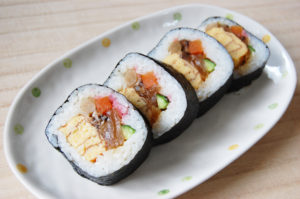
Futo maki is a literally fat roll, and referred as a thicker version of hoso maki. It includes several kinds of ingredients, and the diameter gets more than 5 cm. It is cut into 2-3 cm thick when eaten. Familiar ingredients are egg, seasoned tofu, shiitake mushroom, grilled conger eel, and cucumber, but variations exist depending on the region or the household.
-Gunkan maki
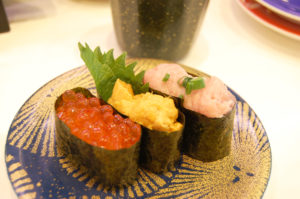
Gunkan maki is another type of rolled sushi, which was created at a sushi restaurant in Ginza in the 1940s. It has a wide strip of seaweed paper around the rice with a little space for putting an ingredient on top. The name “Gunkan” stems from “Battleship” because the shape of gunkan maki resembles it. Popular toppings are uni (sea urchin), ikura (salmon roe), and negitoro (a blend of fatty tuna belly and green onion). Gunkan maki is a popular option at sushi restaurants.
-Temaki
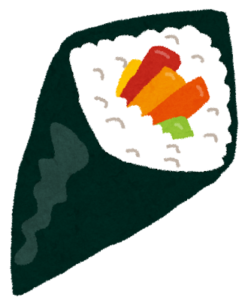
Temaki is literally a hand roll as the word “te” indicates “hand.” It has vinegared rice and whichever fillings you like rolled with a sheet of nori, shaped into like an ice cream cone. Although temaki is getting familiar at sushi restaurants, it is usually made at home due to its easiness and enjoyment. Temaki is a great dish for parties and family dinner because making temaki is a lot of fun and you can put whichever ingredients you want.
3.Chirashizushi
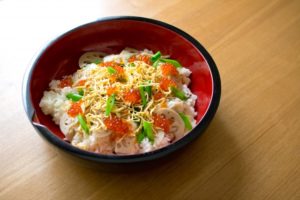
Chirashizushi is a type of sushi which combines the vinegared rice with multiple ingredients. The name “chirashi”(to scatter) is originated from its making process, which the ingredients are “scattered” in the rice or over the rice.
Common ingredients mixed with rice are boiled, seasoned carrot, shiitake mushroom, kampyo, and lotus root, but different regions use different ingredients. After the rice is prepared, seafood, egg, and nori are added as decorations.
Chirashi is often eaten on special occasions especially on Hinamatsuri (Doll Festival or Girl’s Festival).
For more detail about Hinamatsuri, check out this; Hinamatsuri ? Japanese Doll Festival for Girls
4.Inarizushi
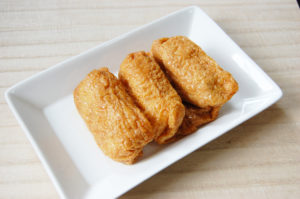
Inarizushi is a little bit different from the other types of sushi in that it does not use any seafood and contains a slightly sweet flavor. Inarizushi has rice mixed with sesame or some kinds of vegetables in a pouch-like piece of Aburaage (deep-fried tofu). Aburaage is simmered in a blended seasoning including soy sauce, mirin, dashi, and sugar. Sometimes additional ingredients such as egg, boiled prawns, or salmon roe are put on the top of inarizushi.
Due to its ease of making and mobility, inarizushi is a popular item for bento and finger food for picnic or parties.
5.Temarizushi
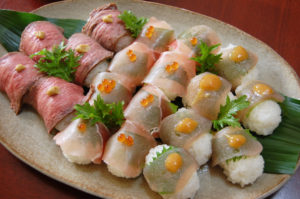
Temarizushi is a small, ball-shaped type of sushi which is usually made at home. “Temari” is a Japanese word of "ball," which became the origin of the name “Temarizushi.” A bite-size ball of rice topped with an ingredient is wrapped with plastic wrap, creating a perfectly round shape.
Temarizushi is also a common dish for bento or parties because of its ease of making and customizing.
6.Oshizushi
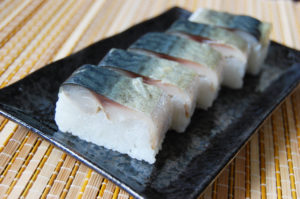
Oshizushi literally means “pressed sushi”, which is made with vinegared rice and an ingredient put into a wooden mold (oshigata) and pressed. Oshizushi resembles nigiri, but is different in that oshizushi is firstly shaped in a mold and then cut into rectangular shapes. Common ingredients used for oshizushi are vinegared mackerel, salmon, and sea bream.
Oshizushi was originated in Osaka, and is still made in some regions around Kansai area (western part of Japan) like Kyoto, Toyama, Tottori, and Hiroshima. Oshizushi is one of the particular commodities in those regions and purchased as gifts.
7.Narezushi
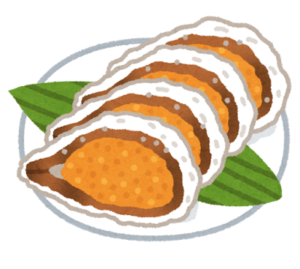
Fermentation used to be a technique to preserve food before refrigeration was invented. Narezushi is one of the examples that used the technique of fermentation- people preserved fish for several months to years in salt and rice, and its origin dates back to the Nara period (710-794).
Narezushi used to be a dish offered to the imperial court in the ancient era. At that time the rice was removed, but over time people came to eat rice as well as the period for fermentation became shortened. In the Edo period (1603~1868), as the vinegar for rice came to be available all over Japan, the Japanese started to use vinegar to add a taste of sour to rice. This is said to be the original form of nigiri.
Today narezushi is not as common as before due to its strong flavor, but still made in some areas in Japan. The most famous one is Funazushi from Shiga prefecture, using crucian carp caught from nearby Lake Biwa.
8.Sasazushi
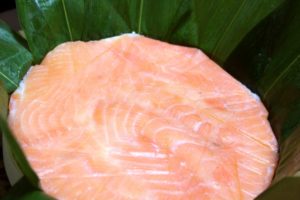
“Sasa” means bamboo leaves, and sasazushi is a kind of sushi containing vinegared rice and toppings wrapped in bamboo leaves. Wrapped in bamboo leaves, the rice and toppings get a subtle aroma from bamboo leaves, creating a neat, distinct flavor.
Toppings can contain bamboo shoot, mountain vegetables, walnuts, carrot, and deep-fried tofu. Each regions has invented its unique sasazushi, making it special to that region.
Sasazushi is said to be rooted in Nagano prefecture during the Sengoku period (1467-1573), and it was created either because the food was served on bamboo leaves, or Nagano locals were seeking for a dish to offer the visiting samurai warlord of that time.
Japanese Sushi Offers Much More Types than You Imagine!
We have introduced 9 types of sushi, but there are more kinds in Japan. Trying different kinds of sushi will give you experiences of enjoying the natural taste of the ingredients, skills of sushi chefs, the history behind the dish, and so on.
Please make sure to try as many types of sushi as possible if you come to Japan!
